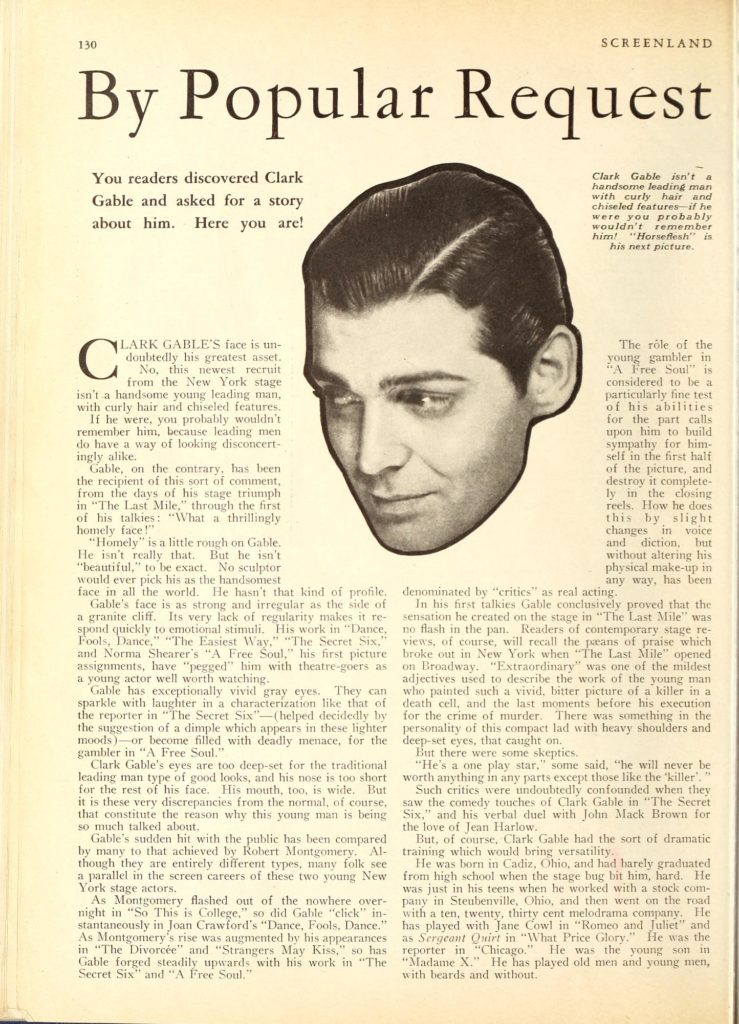1931: By Popular Request

Screenland magazine, August 1931
You readers discovered Clark Gable and asked for a story about him. Here you are!
Clark Gable’s face is undoubtedly his greatest asset. No, this newest recruit from the New York stage isn’t a handsome young man, with curly hair and chiseled features.
If he were, you probably wouldn’t remember him, because leading men do have a way of looking disconcertingly alike.
Gable, on the contrary, has been the recipient of this sort of comment, from the days on his stage triumph in “The Last Mile,” through the first of his talkies: “What a thrillingly homely face!”
“Homely” is a little rough on Gable. He isn’t really that. But he isn’t “beautiful,” to be exact. No sculptor would ever pick his as the handsomest face in all the world. He hasn’t that kind of profile.
Gable’s face is as strong and irregular as the side of a granite cliff. It’s very lack of regularity makes it respond quickly to emotional stimuli. His work in “Dance, Fools, Dance,” “The Easiest Way,” “the Secret Six,” and Norma Shearer’s “A Free Soul,” his first picture assignments, have “pegged” him with theatre-goers as a young actor well worth watching.
Gable has exceptionally vivid gray eyes. They can sparkle with laughter in a characterization like that of the reporter in “The Secret Six”—(helped decidedly by the suggestion of a dimple which appears in these lighter moods)—or become filled with deadly menace, for the gambler in “A Free Soul.”
Clark Gable’s eyes are too deep-set for the traditional leading man type of good looks, and his nose is too short for the rest of his face. His mouth, too, is wide. But it is these very discrepancies from the normal, of course, that constitute the reason why this young man is being so much talked about.
Gable’s sudden hit with the public has been compared by many to that achieved by Robert Montgomery. Although they are certainly different types, many folk see a parallel in the screen careers of these two young New York stage actors.
As Montgomery flashed out of the nowhere overnight in “So This is College,” so did Gable “click” instantaneously in Joan Crawford’s “Dance, Fools, Dance.” As Montgomery’s rise was augmented by his appearances in “The Divorcee” and “Strangers May Kiss,” so has Gable forged steadily upwards with his work in “The Secret Six” and “A Free Soul.”
The role of the young gambler in “A Free Soul” is considered to be a particularly fine test of his abilities for the part calls upon him to build sympathy for himself in the first half of the picture and destroy it completely in the closing reels. How he does this by slight changes in voice and diction, but without altering his physical make-up in any way, has been denominated by “critics” as real acting.
In his first talkies Gable conclusively proved that the sensation he created on the stage in “The Last Mile” was no flash in the pan. Readers of contemporary stage reviews, of course, will recall the paeans of praise which broke out in New York when “The Last Mile” opened on Broadway. “Extraordinary” was one of the mildest adjectives used to describe the work of the young man who painted such a vivid, bitter picture of a killer in a death cell, and the last moments before his execution for the crime of murder. There was something in the personality of this compact lad with heavy shoulders and deep-set eyes, that caught on.
But there were some skeptics.
“He’s a one play star,” some said, “he will never be worth anything in any parts except those like the killer.”
Such critics were undoubtedly confounded when they saw the comedy touches of Clark Gable in “The Secret Six,” and his verbal duel with John Mack Brown for the love of Jean Harlow.
But, of course, Clark Gable had the sort of dramatic training which would bring versatility.
He was born in Cadiz, Ohio, and had barely graduated from high school when the stage bug hit him, hard. He was just in his teens when he worked with a stock company in Steubenville, Ohio, and then went on the road with a ten, twenty, thirty cent melodrama company. He has played with Jane Cowl in “Romeo and Juliet” and as Sergeant Quirt in “What Price Glory.” He was the reporter in “Chicago.” He was the young son in “Madame X.” He has played old men and young men, with beards and without.